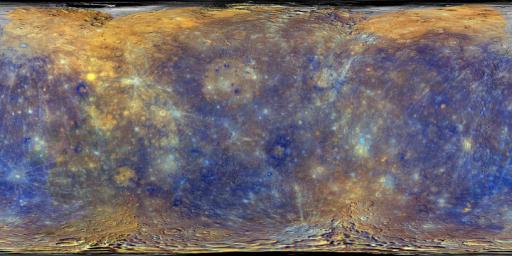
|
Enhanced Color Mercury Map
- Click the image above for a larger view
- Full-Res JPEG (4096 x 2048) (1.8 MB)
- Full-Res TIFF (4096 x 2048) (25.2 MB)
Caption:
This colorful view of Mercury is similar to that used to generate this movie [ 23MB , 6.5MB ] of Mercury as a spinning globe, and these two individual views (centered at 140°E and 320°E ) of the innermost planet. The enhanced color view is overlaid on the global monochrome base map, which is available for download here .
The enhanced color was produced by using images from the color base map imaging campaign during MESSENGER's primary mission. These colors are not what Mercury would look like to the human eye , but rather the colors enhance the chemical, mineralogical, and physical differences between the rocks that make up Mercury's surface. This specific color combination places the second principal component in the red channel, the first principal component in the green channel, and the ratio of the 430 nm/1000 nm filters in the blue channel.
Instrument:
Wide Angle Camera (WAC) of the Mercury Dual Imaging System (MDIS)
Center Latitude:
0°
Center Longitude:
180° E
Map Projection:
Simple cylindrical projection
Resolution:
3.74 km/pixel
Scale:
Mercury's diameter is 4880 kilometers (3030 miles)
Background Info:
The MESSENGER spacecraft is the first ever to orbit the planet Mercury, and the spacecraft's seven scientific instruments and radio science investigation are unraveling the history and evolution of the Solar System's innermost planet. MESSENGER acquired over 150,000 images and extensive other data sets. MESSENGER is capable of continuing orbital operations until early 2015.
For information regarding the use of images, see the MESSENGER image use policy .
Cataloging Keywords:
| Name | Value | Additional Values |
|---|---|---|
| Target | Mercury | |
| System | ||
| Target Type | Planet | |
| Mission | MESSENGER | |
| Instrument Host | MESSENGER | |
| Host Type | Orbiter | |
| Instrument | Mercury Dual Imaging System (MDIS) | |
| Detector | Wide Angle Camera (WAC) | |
| Extra Keywords | Color, Map, Radio, Rotation | |
| Acquisition Date | ||
| Release Date | 2013-07-18 | |
| Date in Caption | ||
| Image Credit | NASA/Johns Hopkins University Applied Physics Laboratory/Carnegie Institution of Washington | |
| Source | photojournal.jpl.nasa.gov/catalog/PIA17386 | |
| Identifier | PIA17386 | |
